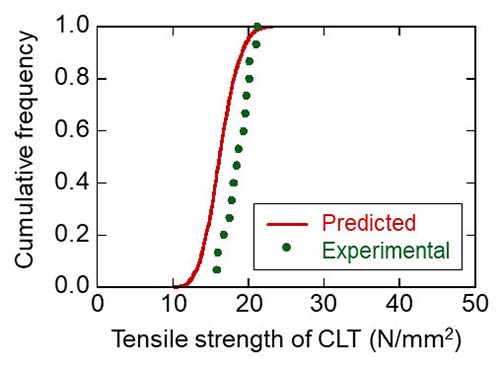Home > Research > Research Results > Research Results 2019 > Computer-Estimating of Strength Properties of Cross-Laminated Timber
Update:March 29, 2019
Main content starts here.
Computer-Estimating of Strength Properties of Cross-Laminated Timber
| Article title |
Monte-Carlo Simulation Model for Predicting the Tensile Strength Distribution of Cross Laminated Timber |
|---|---|
| Author (affiliation) |
Keita OGAWA (a), Hirofumi IDO (a), Masaki HARADA (a), Hirofumi NAGAO (a), Hideo KATO (a), Atsushi MIYATAKE (b) (a) Department of Wood Engineering, FFPRI, Tsukuba, Ibaraki, Japan. (b) Department of Wood-Based Materials, FFPRI, Tsukuba, Ibaraki, Japan. |
| Publication Journal |
Journal of the Society of Materials Science, Japan、67(12):1087-1093, December 2018 |
| Content introduction |
A new Wood-based material which is named Cross-laminated timber (CLT) get a lot of attention recently in World’s building construction market. It is manufactured by adhesively laminating timber laminae such that their grain directions cross mutually. CLT is used as a thick and large plank material for floors and walls of a wooden structure. CLT is expected to be utilized for middle- and high-rise buildings; therefore, it is extremely important to understand the strength properties of CLT as a structural material. Many wooden material varies its strength according to tree species, locality, and individual tree. Accordingly, the CLT strength varies with the laminae used. An ideal method for estimating the strength properties of CLT is to conduct mechanical loading tests using full-scale CLT specimens. However, this testing method requires a large apparatus, and is consuming time and labor because CLT is characterized by its thickness and large plank. Therefore, we developed a computerized method for estimating the strength properties of CLT without depending on practical testing of its laminae. We estimated the tensile strength of CLT using the test results of laminae which is obtained by using a testing machine for evaluating the laminae bending strength (already integrated in a manufacturing machine for Glued Laminated Timber). Using the strength data of the evaluated laminae, we virtually constructed CLT model on a computer using the Monte-Carlo method(note), and calculated the estimated value of its strength based on a tensile fracture model. Repeating 2,000 times this procedure, we virtually estimate the tensile strength of 2,000 of CLT specimens to comprehend their distributions. Because these calculations were performed on a personal computer, the tensile strength data of a large number of test specimens could be obtained without practically testing each piece. Also, we practically conducted a fracture test using the test pieces of CLT to confirm whether the estimated results could be regarded similar to the results obtained from the virtual fracture test. Elucidation of the strength properties of CLT through such research will lead to the promotion and promote the utilization of CLT. (Note) This is a method of estimating the value through a simulation using random numbers. This method can be utilized in several fields because of the development of computers.
Figure1. We developed a method for estimate the distribution of CLT’s tensile strength based on computer calculation using the tensile test results of its laminae. Also, we conducted practical tensile test using full-scale CLT specimens to confirm whether the estimation results could be regarded similar to the results obtained from the virtual fracture test.
|
Copyright © Forest Research and Management Organization. All rights reserved.


